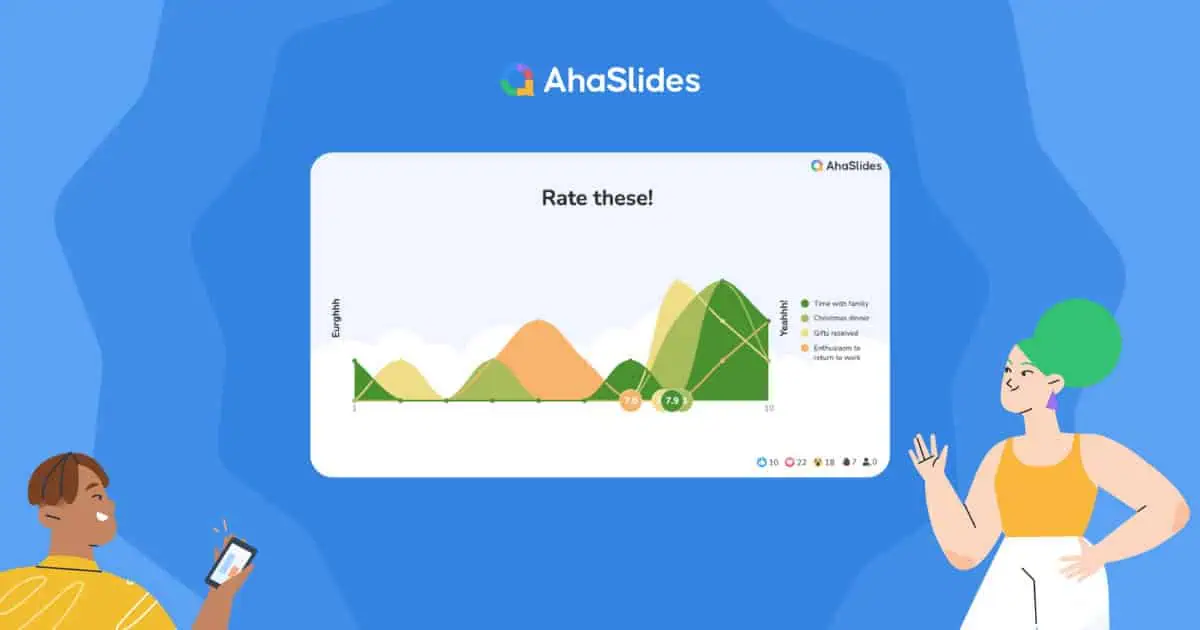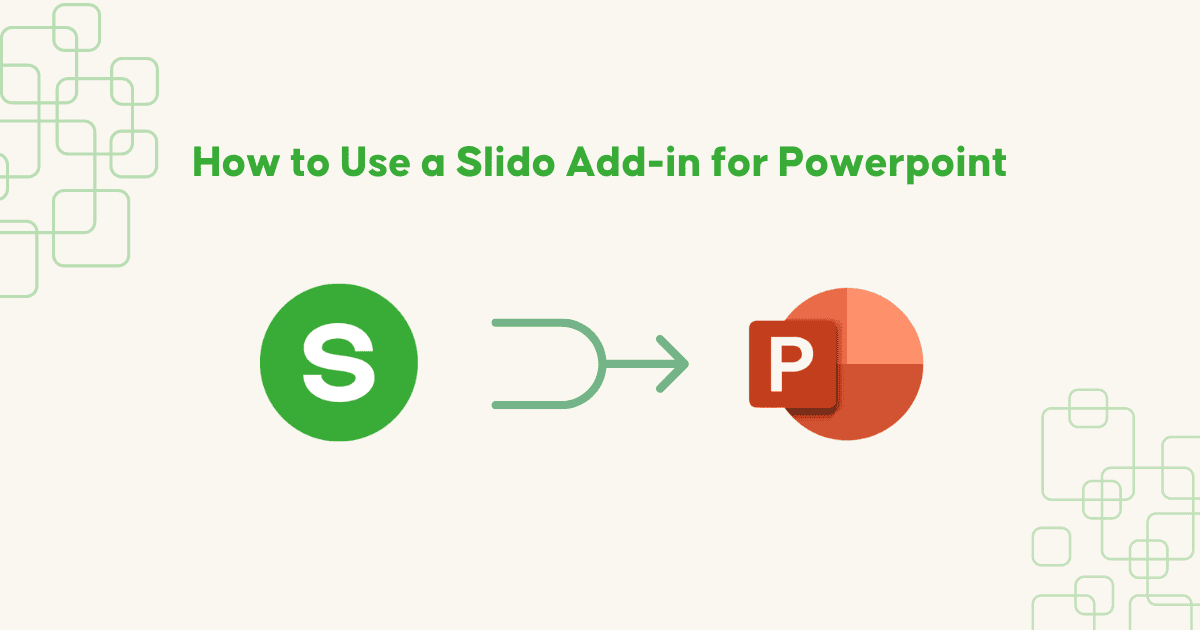Here’s the secret to my next presentation success: a ton of public speaking tips to get you ready and be more confident before your big day.
***
I still remember one of my first public speeches…
When I delivered it at my middle school graduation ceremony, I was very nervous. I got stage fright, felt camera-shy, and had all sorts of horribly embarrassing scenarios looming in my head. My body froze, my hands seemed to be shaking and I kept second-guessing myself.
I had all the classic signs of Glossophobia. I wasn’t ready for that speech, but afterwards, I found some words of advice to help me do better next time.
Check them out below!
- #1 - Know your audience
- #2 - Plan & outline your speech
- #3 - Find a style
- #4 - Pay attention to your intro and end
- #5 - Use visual aids
- #6 - Make good use of notes
- #7 - Rehearse
- #8 - Pace & pause
- #9 - Effective language & movement
- #10 - Relay your message
- #11 - Adapt to the situation
Public Speaking Tips with AhaSlides
Off-Stage Public Speaking Tips
Half of the work you need to do comes before you even step on stage. Good preparation will guarantee you more confidence and better performance.
#1 - Know your Audience
It’s important to understand your audience, as your speech needs to be as relatable to them as possible. It would be pretty pointless to say something they already know or something too overwhelming for them to digest in a short period of time.
You should always attempt to solve a problem that most people are having. Before you even start crafting your speech, try the 5 whys technique. This can really help you to discover and get to the bottom of the problem.
To build a better connection with the crowd, try to figure out what content and messages they care about. Here are 6 questions you might ask to understand your audience and find out what they have in common:
- Who are they?
- What do they want?
- What do you guys have in common?
- What do they know?
- What is their mood?
- What are their doubts, fears and misperceptions?
Read more about each question here.
#2 - Plan & Outline your Speech
Make a plan of what you want to say and then define the key points to create an outline. From the outline, you can list out a few smaller things in each point that you think are essential. Go through everything again to make sure the structure is logical and all ideas are relevant.
There are a lot of structures that you can find and there’s no single trick to it, but you can have a look at this suggested outline for a speech under 20 minutes:
- Start by grabbing your audience's attention (here’s how): in less than 2 minutes.
- Explain your idea clearly and with evidence, like telling a story, to illustrate your points: in about 15 minutes.
- End by summarizing your key points (here’s how): in less than 2 minutes.
#3 - Find a Style
Not everyone has their own unique speaking style, but you should try different approaches to see which one suits you best. It can be casual, humorous, intimate, formal, or one of many other styles.
The most essential thing is to make yourself comfortable and natural when speaking. Don’t force yourself to be someone you’re absolutely not just to gain some love or laughs from the audience; it could make you appear a bit fake.
According to Richard Newman, a speechwriter and keynote speaker, there are 4 different styles for you to choose from, including motivator, commander, entertainer and facilitator. Read more about them and decide which one best suits you, your audience and your message.
#4 - Pay Attention to your Intro and End
Remember to start and end your speech on a high note. A good introduction will grab the crowd’s attention, while a good ending leaves them with a long-lasting impression.
There are a few ways to start your speech, but the easiest one is to start by introducing yourself as a person having something in common with your audience. This is also a good chance to lay out the problem that most of the audience are having, like what I did in this article’s introduction.
And then, at the very last minute, you might end your speech with an inspirational quote or one of many other techniques.
Here’s a TED talk by Sir Ken Robinson, which he ended with a quote from Benjamin Franklin.
#5 - Use Visual Aids
Many times when you’re public speaking, you need no help from the slideshows, it’s just about you and your words. But in other cases, when your topic is rich in detailed information, using some slides with visual aids could be really helpful for your audience to get a clear picture of your message.
Have you ever noticed that even amazing TED speakers use visual aids? That’s because they help them to illustrate the concepts they’re talking about. Data, charts, graphs or photos/videos, for example, can help you explain your points better. In some cases, you can use props to make it more special when relevant.

#6 - Make Good Use of Notes
For a lot of speeches, it’s totally acceptable to make some notes and bring them on stage with you. Not only do they help you remember important parts of your speech, but they can also give you a boost of confidence; it’s much easier to steer through your speech when you know you have your notes to fall back on.
Here’s how to make good notes:
- Write big to help you grasp your ideas more easily.
- Use small pieces of paper to keep your notes discreet.
- Number them in case they get shuffled.
- Follow the outline and write your notes in the same order to avoid messing things up.
- Minimise the words. Just jot down some keywords to remind yourself, don’t write the whole thing.
#7 - Rehearse
Practice speaking a few times before D-day to improve your public speaking skills. It might sound simple, but there are quite a few golden tips to get the most out of your practice time.
- Rehearse on stage - You can try rehearsing on the stage (or the place you’ll stand) to get a feel for the room. Typically, it’s best to stand in the centre and try to stick around that position.
- Have someone as your audience - Try asking a few friends or colleagues to be your audience and see how they react to what you’re saying.
- Choose an outfit - A proper and comfortable outfit will help you feel more composed and professional when doing your speech.
- Make changes - Your material may not always hit its mark in rehearsal, but that’s fine. Don’t be afraid to change some ideas after testing them out.
On Stage Public Speaking Tips
It’s your time to shine! Here are a few tips that you should bear in mind when delivering your wonderful speech.
#8 - Pace & Pause
Pay attention to your pace. Speaking too fast or too slow can either mean your audience miss some of the content of your speech, or that they lose interest because their brains are working faster than your mouth.
And don’t forget to pause. Speaking constantly can make it a bit harder for the audience to digest your information. Chunk your speech down into smaller sections and give a few seconds of silence between them.
If you forget something, carry on with the rest of your speech as best you can (or check your notes). If you stumble, pause for a second, then continue.
You may realise that you’ve forgotten something in your outline, but the audience probably won’t know that, so in their eyes, everything you say is everything you’ve prepared. Don’t let this little stuff ruin your speech or your confidence because you still have the rest to offer them.
#9 - Effective Language and Movement
Telling you to be aware of your body language might be pretty cliche, but it’s a must. Body language is one of the most effective speaking skills to help you build better connections with the audience and get them focused better.
- Eye contact - You should look around the audience zone, but don’t move your eyes too fast. The easiest way is to imagine in your head that there are 3 audience zones, one on the left, in the centre and on the right. Then, when you’re talking, look at each zone for a while (maybe around 5-10 seconds) before moving on to the others.
- Movement - Moving around a few times during your speech would help you look much more natural (of course, only when you’re not standing behind a podium). Taking a few steps to the left, to the right or forward can help you feel more relaxed.
- Hand gestures - If you are holding a microphone in one hand, relax and keep the other hand natural. Watch a few videos to see how great speakers move their hands, then mimic them.
Check out this video and learn from both the speaker’s content and body language.
#10 - Relay your message
Your speech should convey a message to the audience, at times meaningful, thought-provoking or inspiring to make it more memorable. Make sure to bring up the main message of the speech throughout and then summarise it at the end. Check out what Taylor Swift did in her graduation speech at New York University; after telling her story and giving a few short examples, she relayed her message 👇
“And I’m not gonna lie, these mistakes will cause you to lose things.
I’m trying to tell you that losing things doesn’t just mean losing. A lot of the time, when we lose things, we gain things too.”
#11 - Adapt to the Situation
If you see that your audience is losing interest and getting distracted, will you continue everything as planned?
Sometimes you could and should do it differently, like try to interact more with the crowd to liven up the room.
You might stop to ask a couple of questions to gain more interest from the audience and get their attention back to you and your speech. Try using interactive presentation software to ask an open-ended question, or have a simple show of hands.
There aren’t many things you can do on the spot, so there’s another quick and easy way, which is to get yourself off the stage and join the crowd in a few minutes.
Above are some of the best public speaking tips to help you prepare offstage and give you confidence on it. Now, let’s dive into writing the speech, starting with the intro!








